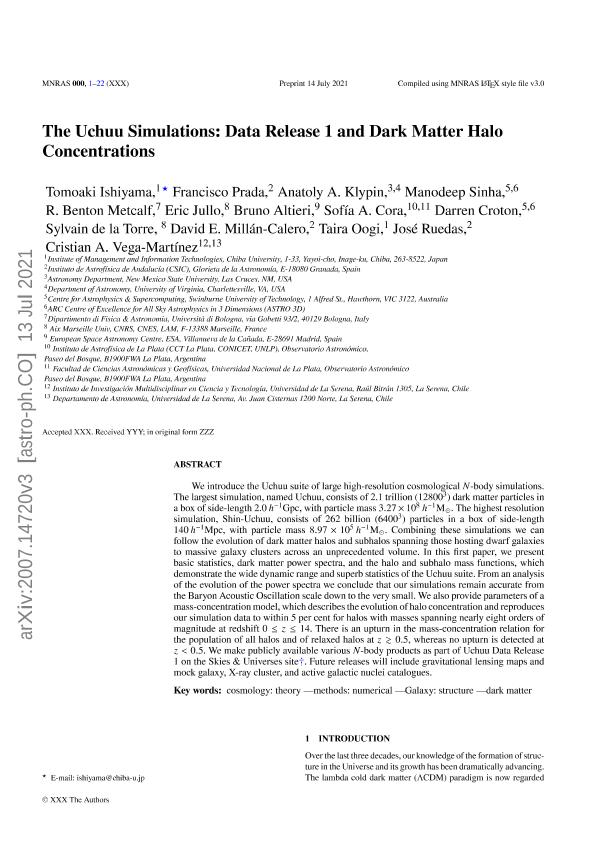Artículo
Asteroseismic analysis of variable hot subdwarf stars observed with TESS : I, the mean g-mode period spacings in hot subdwarf B stars
Uzundag, Murat; Vučković, Maja; Németh, Péter; Miller Bertolami, Marcelo Miguel ; Silvotti, Roberto; Baran, Andrzej S.; Telting, John H.; Reed, Mike; Shoaf, K. A.; Østensen, Roy H.; Sahoo, Sumanta K.
; Silvotti, Roberto; Baran, Andrzej S.; Telting, John H.; Reed, Mike; Shoaf, K. A.; Østensen, Roy H.; Sahoo, Sumanta K.
 ; Silvotti, Roberto; Baran, Andrzej S.; Telting, John H.; Reed, Mike; Shoaf, K. A.; Østensen, Roy H.; Sahoo, Sumanta K.
; Silvotti, Roberto; Baran, Andrzej S.; Telting, John H.; Reed, Mike; Shoaf, K. A.; Østensen, Roy H.; Sahoo, Sumanta K.
Fecha de publicación:
07/2021
Editorial:
EDP Sciences
Revista:
Astronomy and Astrophysics
ISSN:
0004-6361
Idioma:
Inglés
Tipo de recurso:
Artículo publicado
Clasificación temática:
Resumen
Context. We present photometric and spectroscopic analyses of gravity (g-mode) long-period pulsating hot subdwarf B (sdB) stars, also called V1093 Her stars, observed by the TESS space telescope in both 120 s short-cadence and 20 s ultra-short-cadence mode during the survey observation and the extended mission of the southern ecliptic hemisphere. Aims. We perform a detailed asteroseismic and spectroscopic analysis of five pulsating sdB stars observed with TESS aiming at the global comparison of the observations with the model predictions based on our stellar evolution computations coupled with the adiabatic pulsation computations. Methods. We process and analyze TESS observations of long-period pulsating hot subdwarf B stars. We perform standard prewhitening techniques on the datasets to extract the pulsation periods from the TESS light curves. We apply standard seismic tools for mode identification, including asymptotic period spacings and rotational frequency multiplets. Based on the values obtained from Kolmogorov-Smirnov and Inverse Variance tests, we search for a constant period spacing for dipole (l = 1) and quadrupole (l = 2) modes. We calculate the mean period spacing for l = 1 and l = 2 modes and estimate the errors by means of a statistical resampling analysis. For all stars, atmospheric parameters were derived by fitting synthetic spectra to the newly obtained low-resolution spectra. We have computed stellar evolution models using LPCODE stellar evolution code, and computed l = 1 g-mode frequencies with the adiabatic non-radial pulsation code LP-PUL. Derived observational mean period spacings are then compared to the mean period spacings from detailed stellar evolution computations coupled with the adiabatic pulsation computations of g-modes. Results. We detect 73 frequencies, most of which are identified as dipole and quadrupole g-modes with periods spanning from ∼ 3 000 s to ∼ 14 500 s. The derived mean period spacing of dipole modes is concentrated in a narrow region ranging from 251 s to 256 s, while the mean period spacing for quadrupole modes spans from 145 s to 154 s. The atmospheric parameters derived from spectroscopic data are typical of long-period pulsating sdB stars with the effective temperature ranging from 23 700 K to 27 600 K and surface gravity spanning from 5.3 dex to 5.5 dex. In agreement with the expectations from theoretical arguments and previous asteroseismological works, we find that the mean period spacings obtained for models with small convective cores, as predicted by a pure Schwarzschild criterion, are incompatible with the observations. We find that models with a standard/modest convective boundary mixing at the boundary of the convective core are in better agreement with the observed mean period spacings and are therefore more realistic. Conclusions. Using high-quality space-based photometry collected by the TESS mission coupled with low-resolution spectroscopy from the ground, we have provided a global comparison of the observations with model predictions by means of a robust indicator such as the mean period spacing. All five objects that we analyze in this work show a remarkable homogeneity in both seismic and spectroscopic properties.
Palabras clave:
asteroseismology
Archivos asociados
Licencia
Identificadores
Colecciones
Articulos(IALP)
Articulos de INST.DE ASTROFISICA LA PLATA
Articulos de INST.DE ASTROFISICA LA PLATA
Citación
Uzundag, Murat; Vučković, Maja; Németh, Péter; Miller Bertolami, Marcelo Miguel; Silvotti, Roberto; et al.; Asteroseismic analysis of variable hot subdwarf stars observed with TESS : I, the mean g-mode period spacings in hot subdwarf B stars; EDP Sciences; Astronomy and Astrophysics; 651; A121; 7-2021; 1-19
Compartir
Altmétricas



